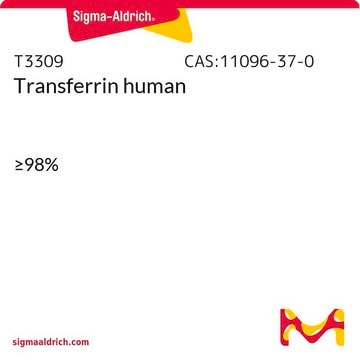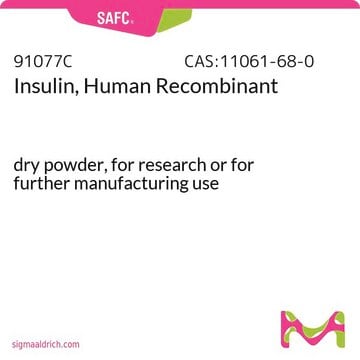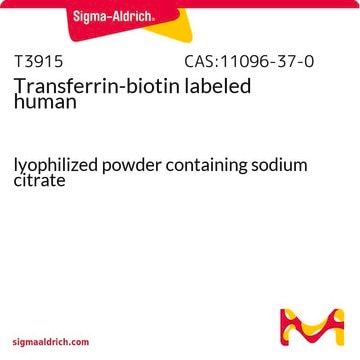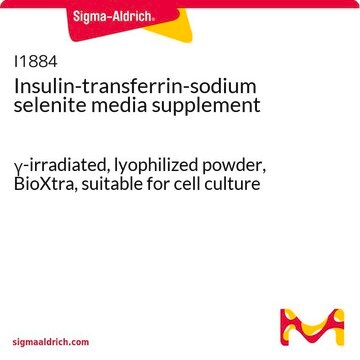Human transferrin has an approximate molecular weight range of 76-81 kDa. Please see the link below to review additional information available in the product datasheet:
https://www.sigmaaldrich.com/deepweb/assets/sigmaaldrich/product/documents/418/013/t8158pis.pdf
T8158
Transferrin human
powder, BioReagent, suitable for cell culture
Synonym(s):
Siderophilin, partially saturated
Select a Size
Select a Size
About This Item
Recommended Products
product line
BioReagent
Quality Level
assay
≥98%
form
powder
concentration
~25 mM
technique(s)
cell culture | mammalian: suitable
impurities
endotoxin, tested
hepatitis and HIV antibody, none detected
solubility
H2O: 50 mg/mL
UniProt accession no.
shipped in
ambient
storage temp.
−20°C
Gene Information
human ... TF(7018)
Looking for similar products? Visit Product Comparison Guide
General description
Application
- to incubate human proximal tubule cells (HKC) - 8 cells along with IgG for the examination of albumin specificity[2]
- as a supplement in serum-containing/devoid medium for human thyroid cell culture[3]
- as a target glycoprotein to develop an in-gel hydrazinolysis method[4]
Biochem/physiol Actions
Other Notes
Preparation Note
Analysis Note
Disclaimer
related product
Storage Class
11 - Combustible Solids
wgk_germany
WGK 3
flash_point_f
Not applicable
flash_point_c
Not applicable
Choose from one of the most recent versions:
Already Own This Product?
Find documentation for the products that you have recently purchased in the Document Library.
Customers Also Viewed
Articles
Understand how transferrin affects serum-free cell culture systems, crucial for biomanufacturing heterologous proteins like monoclonal antibodies.
-
I want to know the Molecular Weight of this product.
1 answer-
Helpful?
-
-
What is the correct method for storing item T8158, Human Transferrin, after reconstitution?
1 answer-
After reconstitution, it is advisable to aliquot and freeze the product T8158, Human Transferrin at -20°C for long-term storage or add NaN₃ and refrigerate it at 4°C for short-term storage. Stock solutions can remain stable for up to 1 year at -20°C or for up to 2 weeks at 4°C.
Helpful?
-
-
We were wondering how to store the dissolved transferrin. We have frozen it at -80. If we thaw it can we can freeze it again,
1 answer-
Transferrin is fairly stable in solution. Non-sterile aqueous solutions may be stored at 4 °C for 5-10 days. Solutions may be filter-sterilized to extend solution stability. Various media supplements containing transferrin, such as ITS (Insulin/Transferrin/Selenium), are stable for up to 30 days at 4 °C and may be stored in frozen aliquots at -20 °C. for up to one year. Avoid repeated freeze/thaw cycles as this may contribute to precipitation occurring.
Helpful?
-
-
How is this protein produced and what is the rest 2% impurity? Thanks!
1 answer-
The preparation method is considered proprietary. The residual impurities have not been identified. This product is tested for endotoxin and iron. Please see the Sample Certificates of Analysis:
https://www.sigmaaldrich.com/certificates/sapfs/PROD/sap/certificate_pdfs/COFA/Q14/T8158-BULKBCCK4250.pdfHelpful?
-
-
What is the Department of Transportation shipping information for this product?
1 answer-
Transportation information can be found in Section 14 of the product's (M)SDS.To access the shipping information for this material, use the link on the product detail page for the product.
Helpful?
-
-
What is the carbohydrate content of human transferrin?
1 answer-
We have found the information on transferrin in a reference book:The Plasma Proteins, F.W. Putnam, ed, volume 2, chapter 4, Table II.According to the table, Transferrin is 6 percent carbohydrate, citing G.A. Jamieson, J. Biol. Chem. 240(7), 2914-2920 (1965).The table also gives information on the percentage of each type of monosaccharide that is present.
Helpful?
-
Active Filters
Our team of scientists has experience in all areas of research including Life Science, Material Science, Chemical Synthesis, Chromatography, Analytical and many others.
Contact Technical Service













